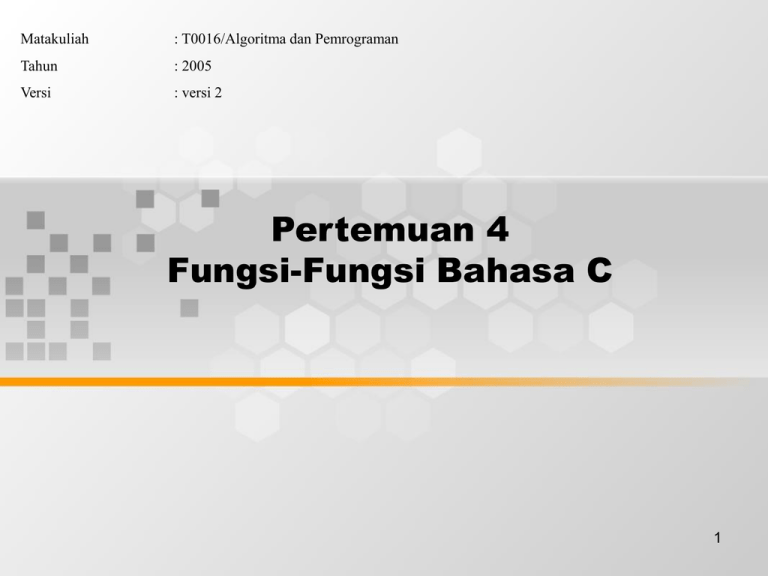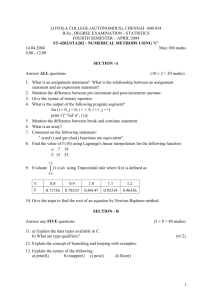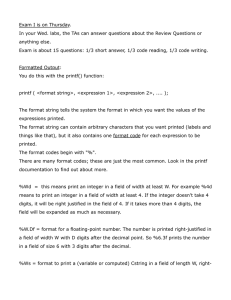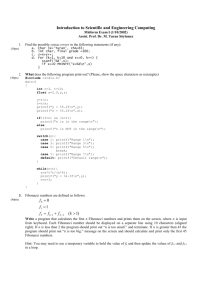
Matakuliah
: T0016/Algoritma dan Pemrograman
Tahun
: 2005
Versi
: versi 2
Pertemuan 4
Fungsi-Fungsi Bahasa C
1
Learning Outcomes
Pada akhir pertemuan ini, diharapkan
mahasiswa akan mampu :
• Mendemonstrasikan penulisan program
dengan menggunakan instruksi I/O dan
pengaturan cursor
2
Outline Materi
• scanf(), printf(), etc
• Pengaturan cursor
• Pembersihan layar
3
4
9.1
Introduction
• In this chapter
– Presentation of results
– scanf and printf
– Streams (input and output)
• gets, puts, getchar, putchar (in <stdio.h>)
2000 Prentice Hall, Inc. All rights reserved.
5
9.2
Streams
• Streams
– Sequences of characters organized into lines
• Each line consists of zero or more characters and ends with
newline character
• ANSI C must support lines of at least 254 characters
– Performs all input and output
– Can often be redirected
•
•
•
•
Standard input – keyboard
Standard output – screen
Standard error – screen
More Chapter 11
2000 Prentice Hall, Inc. All rights reserved.
6
9.3
Formatting Output with printf
• printf
– Precise output formatting
• Conversion specifications: flags, field widths, precisions, etc.
– Can perform rounding, aligning columns, right/left
justification, inserting literal characters, exponential format,
hexadecimal format, and fixed width and precision
• Format
– printf( format-control-string, other-arguments );
– Format control string: describes output format
– Other-arguments: correspond to each conversion
specification in format-control-string
• Each specification begins with a percent sign(%), ends with
conversion specifier
2000 Prentice Hall, Inc. All rights reserved.
7
9.4
Printing Integers
• Integer
– Whole number (no decimal point): 25, 0, -9
– Positive, negative, or zero
– Only minus sign prints by default (later we shall change this)
Conversion Sp ec ifier Desc rip tion
d
i
Display a signed decimal integer.
Display a signed decimal integer. (Note: The i and d specifiers
are different when used with scanf.)
o
u
x or X
Display an unsigned octal integer.
Display an unsigned decimal integer.
Display an unsigned hexadecimal integer. X causes the digits 0-9
and the letters A-F to be displayed and x causes the digits 0-9 and
a-f to be displayed.
h or l (letter l)
Place before any integer conversion specifier to indicate that a
short or long integer is displayed respectively. Letters h and l
are more precisely called length modifiers.
2000 Prentice Hall, Inc. All rights reserved.
1
2
3
4
5
6
7
8
9
10
11
12
13
14
15
16
17
18
19
20
/* Fig 9.2: fig09_02.c */
8
Outline
/* Using the integer conversion specifiers */
#include <stdio.h>
int main()
{
printf(
printf(
printf(
printf(
printf(
printf(
printf(
printf(
printf(
printf(
printf(
1. Print
"%d\n", 455 );
"%i\n", 455 ); /* i same as d in printf */
"%d\n", +455 );
"%d\n", -455 );
"%hd\n", 32000 );
"%ld\n", 2000000000 );
"%o\n", 455 );
"%u\n", 455 );
"%u\n", -455 );
"%x\n", 455 );
"%X\n", 455 );
return 0;
}
455
455
455
-455
32000
2000000000
707
455
65081
1c7
1C7
2000 Prentice Hall, Inc. All rights reserved.
Program Output
9
9.5
Printing Floating-Point Numbers
• Floating Point Numbers
– Have a decimal point (33.5)
– Exponential notation (computer's version of scientific
notation)
• 150.3 is 1.503 x 10² in scientific
• 150.3 is 1.503E+02 in exponential (E stands for exponent)
• use e or E
– f – print floating point with at least one digit to left of
decimal
– g (or G) - prints in f or e with no trailing zeros (1.2300
becomes 1.23)
• Use exponential if exponent less than -4, or greater than or
equal to precision (6 digits by default)
2000 Prentice Hall, Inc. All rights reserved.
1
2
3
4
5
6
7
8
9
10
11
12
13
14
15
16
17
18
/* Fig 9.4: fig09_04.c */
/* Printing floating-point numbers with
floating-point conversion specifiers */
"%e\n",
"%e\n",
"%e\n",
"%E\n",
"%f\n",
"%g\n",
"%G\n",
Outline
1. Print
#include <stdio.h>
int main()
{
printf(
printf(
printf(
printf(
printf(
printf(
printf(
10
1234567.89 );
+1234567.89 );
-1234567.89 );
1234567.89 );
1234567.89 );
1234567.89 );
1234567.89 );
return 0;
}
1.234568e+006
1.234568e+006
-1.234568e+006
1.234568E+006
1234567.890000
1.23457e+006
1.23457E+006
2000 Prentice Hall, Inc. All rights reserved.
Program Output
11
9.6
Printing Strings and Characters
•c
– Prints char argument
– Cannot be used to print the first character of a string
•s
– Requires a pointer to char as an argument
– Prints characters until NULL ('\0') encountered
– Cannot print a char argument
• Remember
– Single quotes for character constants ('z')
– Double quotes for strings "z" (which actually contains two
characters, 'z' and '\0')
2000 Prentice Hall, Inc. All rights reserved.
1 /* Fig 9.5: fig09_05c */
2 /* Printing strings and characters */
3 #include <stdio.h>
4
5 int main()
6 {
7
char character = 'A';
8
char string[] = "This is a string";
9
const char *stringPtr = "This is also a string";
10
11
12
13
14
15
16
17 }
printf(
printf(
printf(
printf(
"%c\n",
"%s\n",
"%s\n",
"%s\n",
12
Outline
1. Initialize variables
2. Print
character );
"This is a string" );
string );
stringPtr );
return 0;
A
This is a string
This is a string
This is also a string
2000 Prentice Hall, Inc. All rights reserved.
Program Output
13
9.7
Other Conversion Specifiers
•p
– Displays pointer value (address)
•n
– Stores number of characters already output by current
printf statement
– Takes a pointer to an integer as an argument
– Nothing printed by a %n specification
– Every printf call returns a value
• Number of characters output
• Negative number if error occurs
•%
– Prints a percent sign
– %%
2000 Prentice Hall, Inc. All rights reserved.
1 /* Fig 9.7: fig09_07.c */
2 /* Using the p, n, and % conversion specifiers */
3 #include <stdio.h>
4
5 int main()
6 {
7
int *ptr;
8
int x = 12345, y;
9
10
ptr = &x;
11
printf( "The value of ptr is %p\n", ptr );
12
printf( "The address of x is %p\n\n", &x );
13
14
printf( "Total characters printed on this line is:%n", &y );
15
printf( " %d\n\n", y );
16
17
y = printf( "This line has 28 characters\n" );
18
printf( "%d characters were printed\n\n", y );
19
20
printf( "Printing a %% in a format control string\n" );
21
22
return 0;
23 }
The value of ptr is 0065FDF0
The address of x is 0065FDF0
Total characters printed on this line is: 41
This line has 28 characters
28 characters were printed
Printing a % in a format control string
2000 Prentice Hall, Inc. All rights reserved.
14
Outline
1. Initialize variables
2. Print
Program Output
15
9.8
Printing with Field Widths and
Precisions
• Field width
– Size of field in which data is printed
– If width larger than data, default right justified
• If field width too small, increases to fit data
• Minus sign uses one character position in field
– Integer width inserted between % and conversion specifier
– %4d – field width of 4
2000 Prentice Hall, Inc. All rights reserved.
16
9.8
Printing with Field Widths and
Precisions
• Precision
– Meaning varies depending on data type
– Integers (default 1)
• Minimum number of digits to print
– If data too small, prefixed with zeros
– Floating point
• Number of digits to appear after decimal (e and f)
– For g – maximum number of significant digits
– Strings
• Maximum number of characters to be written from string
– Format
• Use a dot (.) then precision number after %
%.3f
2000 Prentice Hall, Inc. All rights reserved.
17
9.8
Printing with Field Widths and
Precisions
• Field width and precision
– Can both be specified
• %width.precision
%5.3f
– Negative field width – left justified
– Positive field width – right justified
– Precision must be positive
– Can use integer expressions to determine field width and
precision values
• Place an asterisk (*) in place of the field width or precision
– Matched to an int argument in argument list
• Example:
printf( "%*.*f", 7, 2, 98.736 );
2000 Prentice Hall, Inc. All rights reserved.
1
2
3
4
5
6
7
8
9
10
11
12
13
14
15
16
17
18
19
20
/* Fig 9.9: fig09_09.c */
/* Using precision while printing integers,
floating-point numbers, and strings */
#include <stdio.h>
18
Outline
1. Initialize variables
int main()
{
int i = 873;
double f = 123.94536;
char s[] = "Happy Birthday";
printf(
printf(
printf(
printf(
printf(
printf(
2. Print
"Using precision for integers\n" );
"\t%.4d\n\t%.9d\n\n", i, i );
"Using precision for floating-point numbers\n" );
"\t%.3f\n\t%.3e\n\t%.3g\n\n", f, f, f );
"Using precision for strings\n" );
"\t%.11s\n", s );
return 0;
}
Using precision for integers
0873
000000873
Using precision for floating-point numbers
123.945
1.239e+02
124
Using precision for strings
Happy Birth
2000 Prentice Hall, Inc. All rights reserved.
Program Output
9.9
Using Flags in the printf
Format-Control String
• Flags
– Supplement formatting capabilities
– Place flag immediately to the right of percent sign
– Several flags may be combined
Fla g
Desc rip tion
- (minus sign)
Left-justify the output within the specified field.
+ (plus sign)
Display a plus sign preceding positive values and a minus sign preceding negative
values.
Print a space before a positive value not printed with the + flag.
space
#
Prefix 0 to the output value when used with the octal conversion specifier o.
Prefix 0x or 0X to the output value when used with the hexadecimal conversion
specifiers x or X.
Force a decimal point for a floating-point number printed with e, E, f, g or G that
does not contain a fractional part. (Normally the decimal point is only printed if a
digit follows it.) For g and G specifiers, trailing zeros are not eliminated.
0 (zero)
Pad a field with leading zeros.
2000 Prentice Hall, Inc. All rights reserved.
19
1
/* Fig 9.11: fig09_11.c */
2
/* Right justifying and left justifying values */
20
Outline
3 #include <stdio.h>
4
1. Print
5
int main()
6
{
7
printf( "%10s%10d%10c%10f\n\n", "hello", 7, 'a', 1.23 );
8
printf( "%-10s%-10d%-10c%-10f\n", "hello", 7, 'a', 1.23 );
9
return 0;
10 }
hello
hello
7
7
a
a
1.230000
1.230000
2000 Prentice Hall, Inc. All rights reserved.
Program Output
1
2
3
4
5
6
7
8
9
10
11
12
13
14
15
16
17
18
/* Fig 9.14: fig09_14.c */
/* Using the # flag with conversion specifiers
o, x, X and any floating-point specifier */
#include <stdio.h>
21
Outline
1. Initialize variables
int main()
{
int c = 1427;
double p = 1427.0;
printf(
printf(
printf(
printf(
printf(
2. Print
"%#o\n", c );
"%#x\n", c );
"%#X\n", c );
"\n%g\n", p );
"%#g\n", p );
return 0;
}
02623
0x593
0X593
1427
1427.00
2000 Prentice Hall, Inc. All rights reserved.
Program Output
22
9.10 Printing Literals and Escape
Sequences
• Printing Literals
– Most characters can be printed
– Certain "problem" characters, such as the quotation mark "
– Must be represented by escape sequences
• Represented by a backslash \ followed by an escape character
2000 Prentice Hall, Inc. All rights reserved.
23
9.10 Printing Literals and Escape
Sequences
• Table of all escape sequences
Esc a p e seq uenc e Desc rip tion
\'
Output the single quote (') character.
\"
Output the double quote (") character.
\?
Output the question mark (?) character.
\\
Output the backslash (\) character.
Cause an audible (bell) or visual alert.
Move the cursor back one position on the current line.
Move the cursor to the start of the next logical page.
Move the cursor to the beginning of the next line.
Move the cursor to the beginning of the current line.
Move the cursor to the next horizontal tab position.
Move the cursor to the next vertical tab position.
\a
\b
\f
\n
\r
\t
\v
2000 Prentice Hall, Inc. All rights reserved.
24
9.11 Formatting Input with Scanf
• scanf
– Input formatting
– Capabilities
• Input all types of data
• Input specific characters
• Skip specific characters
• Format
– scanf(format-control-string, other-arguments);
– Format-control-string
• Describes formats of inputs
– Other-arguments
• Pointers to variables where input will be stored
– Can include field widths to read a specific number of
characters from the stream
2000 Prentice Hall, Inc. All rights reserved.
25
9.11 Formatting Input with Scanf
Conversion sp ec ifier
Integers
d
i
o
u
x or X
h or l
Floating-point numbers
e, E, f, g or G
l or L
Desc rip tion
Read an optionally signed decimal integer. The corresponding
argument is a pointer to integer.
Read an optionally signed decimal, octal, or hexadecimal integer.
The corresponding argument is a pointer to integer.
Read an octal integer. The corresponding argument is a pointer to
unsigned integer.
Read an unsigned decimal integer. The corresponding argument is
a pointer to unsigned integer.
Read a hexadecimal integer. The corresponding argument is a
pointer to unsigned integer.
Place before any of the integer conversion specifiers to indicate
that a short or long integer is to be input.
Read a floating-point value. The corresponding argument is a
pointer to a floating-point variable.
Place before any of the floating-point conversion specifiers to
indicate that a double or long double value is to be input.
2000 Prentice Hall, Inc. All rights reserved.
26
9.11 Formatting Input with Scanf
• Table continued from previous slide
Co nversio n Sp ec ifier Desc rip tio n
Characters and strings
c
s
Scan set
[scan characters
Miscellaneous
p
n
%
Read a character. The corresponding argument is a pointer to
char, no null ('\0') is added.
Read a string. The corresponding argument is a pointer to an array
of type char that is large enough to hold the string and a
terminating null ('\0') character—which is automatically added.
Scan a string for a set of characters that are stored in an array.
Read an address of the same form produced when an address is
output with %p in a printf statement.
Store the number of characters input so far in this scanf. The
corresponding argument is a pointer to integer
Skip a percent sign (%) in the input.
2000 Prentice Hall, Inc. All rights reserved.
27
9.11 Formatting Input with Scanf
• Scan sets
– Set of characters enclosed in square brackets []
• Preceded by % sign
– Scans input stream, looking only for characters in scan set
• Whenever a match occurs, stores character in specified array
• Stops scanning once a character not in the scan set is found
– Inverted scan sets
• Use a caret ^: [^aeiou]
• Causes characters not in the scan set to be stored
• Skipping characters
– Include character to skip in format control
– Or, use * (assignment suppression character)
• Skips any type of character without storing it
2000 Prentice Hall, Inc. All rights reserved.
1
2
3
4
5
6
7
8
9
10
11
12
13
14
15
16
17
/* Fig 9.20: fig09_20.c */
/* Reading characters and strings */
#include <stdio.h>
int main()
{
char x, y[ 9 ];
printf( "Enter a string: " );
scanf( "%c%s", &x, y );
28
Outline
1. Initialize variables
2. Input
3. Print
printf( "The input was:\n" );
printf( "the character \"%c\" ", x );
printf( "and the string \"%s\"\n", y );
return 0;
}
Enter a string: Sunday
The input was:
the character "S" and the string "unday"
2000 Prentice Hall, Inc. All rights reserved.
Program Output
1
2
3
4
5
6
7
8
9
10
11
12
13
14
/* Fig 9.22: fig09_22.c */
/* Using an inverted scan set */
#include <stdio.h>
int main()
{
char z[ 9 ] = { '\0' };
printf( "Enter a string: " );
scanf( "%[^aeiou]", z );
printf( "The input was \"%s\"\n", z );
29
Outline
1. Initialize variable
2. Input
3. Print
return 0;
}
Enter a string: String
The input was "Str"
2000 Prentice Hall, Inc. All rights reserved.
Program Output
1
2
3
4
5
6
7
8
9
10
11
12
13
14
15
16
17
18
19
/* Fig 9.24: fig09_24.c */
/* Reading and discarding characters from the input stream */
#include <stdio.h>
int main()
{
int month1, day1, year1, month2, day2, year2;
printf( "Enter a date in the form mm-dd-yyyy: " );
scanf( "%d%*c%d%*c%d", &month1, &day1, &year1 );
printf( "month = %d day = %d year = %d\n\n",
month1, day1, year1 );
printf( "Enter a date in the form mm/dd/yyyy: " );
scanf( "%d%*c%d%*c%d", &month2, &day2, &year2 );
printf( "month = %d day = %d year = %d\n",
month2, day2, year2 );
30
Outline
1. Initialize variables
2. Input
3. Print
return 0;
}
Enter a date in the form mm-dd-yyyy: 11-18-2000
month = 11 day = 18 year = 2000
Enter a date in the form mm/dd/yyyy: 11/18/2000
month = 11 day = 18 year = 2000
2000 Prentice Hall, Inc. All rights reserved.
Program Output
Penutup
• Bahasa C mempunyai beberapa fungsi
standar untuk menerima input dan
menampilkan output ke monitor
31




